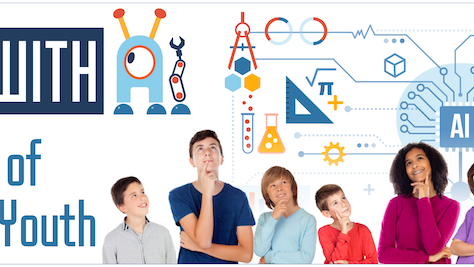Introduction
Information Technology (IT) is the use of digital tools, computers, and communication systems to collect, process, and share information. In today’s world, IT is at the heart of almost every activity—education, business, healthcare, entertainment, and even daily communication. It is not only a subject of study but also a vital force shaping the future of society.
For the young generation, IT is especially important because they are growing up in a technology-driven era. From online learning and skill development to career opportunities and social interaction, technology influences every aspect of their lives. With the right knowledge and responsible use, IT empowers youth to become innovators, problem-solvers, and leaders of tomorrow.
At the same time, technology brings both opportunities and responsibilities. It can open doors to growth and creativity, but misuse can lead to challenges like distraction, dependency, and cyber risks. Therefore, young people must learn how to use IT wisely to build a strong and successful future.
1. Educational Growth
Information Technology has transformed the way young people learn and access knowledge. In the past, education was limited to classrooms and printed books, but today IT provides countless resources through the internet, digital libraries, and online learning platforms. Students can attend virtual classes, watch video lectures, and download e-books anytime, anywhere.
Online learning platforms such as Coursera, Khan Academy, Udemy, and EdX offer courses on a wide range of subjects, often free or low-cost. These platforms allow learners to study at their own pace and even earn certificates recognized globally.
IT also provides access to e-books, digital libraries, and virtual classrooms. E-books allow students to carry hundreds of books on a single device, while digital libraries provide research papers and reference materials from around the world. Virtual classrooms enable interaction with teachers and peers in real time, making learning more engaging and collaborative.
Overall, IT makes knowledge more accessible, flexible, and affordable, allowing young people to explore diverse subjects, gain skills, and prepare for higher education and future careers.
2. Career Opportunities
Information Technology has opened up a wide range of career opportunities for the young generation. Many modern jobs require IT skills in areas such as software development, data science, cybersecurity, digital marketing, and artificial intelligence. Learning these skills enhances employability and prepares youth for high-demand careers.
Rising demand for IT-related skills like coding, AI, and data analytics allows youth to stay competitive in the global job market. Mastery of programming languages and analytical tools enables them to solve complex problems and contribute to technological advancements.
IT also enables freelancing, remote work, and global opportunities. Platforms like Upwork, Fiverr, and Freelancer allow youth to work for international clients from anywhere in the world. Remote jobs offer flexibility, exposure to diverse work cultures, and professional experience.
Furthermore, IT supports digital entrepreneurship and startups. Young people can launch online businesses, develop apps, or offer services on platforms like Shopify, Etsy, and social media. IT tools also aid marketing, analytics, and customer engagement, helping startups grow efficiently.
In short, IT equips youth with the skills, resources, and platforms needed to pursue diverse careers, succeed professionally, and even become entrepreneurs.
3. Social Connectivity & Communication
Information Technology has revolutionized how young people communicate and connect. Through social media platforms, messaging apps, and video calls, youth can maintain relationships, share ideas, and collaborate globally. Platforms like Facebook, Instagram, WhatsApp, and LinkedIn also offer opportunities for networking and professional growth.
Social media influence is significant, providing exposure to trends, educational content, and creative expression. Positive uses include networking, raising awareness, and gaining global exposure, which broaden perspectives and encourage engagement with diverse cultures and ideas.
However, IT also presents risks such as digital addiction, misinformation, and cyberbullying. Excessive screen time can affect productivity and social skills, while online harassment and exposure to false content may harm mental health. By practicing responsible use and developing digital literacy, youth can enjoy the benefits of connectivity while minimizing negative impacts.
4. Innovation & Creativity
Information Technology fosters innovation and creativity among young people. Digital tools and software enable them to transform ideas into practical solutions, artistic creations, and technological innovations.
IT provides tools for creative expression. Graphic design software like Adobe Photoshop and Canva allows youth to create visuals, while music production apps such as FL Studio and GarageBand enable composing and editing music. Video editing tools like Adobe Premiere Pro, CapCut, and Final Cut Pro help produce professional-quality videos.
Youth are also using apps, websites, and AI tools to innovate. Platforms like Scratch, GitHub, and Canva AI enable the development of apps, content creation, and problem-solving, while AI tools like ChatGPT and DALL·E help generate digital solutions efficiently.
Furthermore, IT encourages problem-solving and critical thinking. Online simulations, coding exercises, and collaborative platforms challenge youth to analyze problems, test solutions, and refine strategies, preparing them to tackle real-world challenges creatively.
In summary, IT empowers young people to be creators, innovators, and problem-solvers, equipping them with skills and creativity essential for modern life.
5. Personal Development
Information Technology contributes significantly to the personal development of youth. Access to online resources, tutorials, and courses allows young people to acquire knowledge, develop skills, and grow intellectually.
IT enhances digital literacy, enabling youth to search for reliable information, communicate effectively, and use software tools responsibly. Exposure to global cultures and ideas broadens perspectives, encourages adaptability, and nurtures open-mindedness.
IT also promotes self-improvement and goal-setting. Students can track learning progress, engage in online challenges, and access motivational content. By using technology mindfully, they can balance learning, creativity, and social engagement, preparing for both academic and professional success.
6. Challenges & Risks
Despite its benefits, Information Technology presents challenges and risks.
- Overdependence on technology: Excessive use of digital devices can reduce physical activity, weaken social skills, and hinder real-world problem-solving.
- Cybersecurity threats: Young people may face online scams, identity theft, or data breaches without proper knowledge of digital safety.
- Digital distractions: Social media, gaming, and online entertainment can divert attention from important tasks like studying or skill development.
- Exposure to harmful content: The internet may expose youth to misinformation, cyberbullying, or inappropriate content, which can negatively affect behavior or mental health.
By practicing responsible technology use, developing digital literacy, and setting boundaries, youth can enjoy IT’s benefits while minimizing its risks.
7. Future Outlook
The future of Information Technology promises even greater opportunities for young people. Emerging fields like AI, robotics, blockchain, virtual reality, and IoT will create new avenues for learning, innovation, and career development.
Youth who embrace IT today will be better prepared to adapt to these changes, acquire future-ready skills, and participate in global projects. Continuous learning and upskilling will be essential as technology-driven industries evolve rapidly.
By using IT responsibly, young people can become leaders, innovators, and problem-solvers, shaping a future that is more inclusive, creative, and technologically advanced.
Conclusion
Information Technology plays a vital role in shaping the future of young people. From educational growth and career opportunities to social connectivity, innovation, and personal development, IT provides tools and resources that empower youth to learn, create, and succeed.
At the same time, technology comes with challenges and responsibilities, including managing digital distractions, ensuring cybersecurity, and using social media wisely. By embracing IT responsibly, young people can harness its potential while avoiding its risks.
Ultimately, Information Technology is both a powerful opportunity and a responsibility. When used effectively, it equips youth with the knowledge, skills, creativity, and critical thinking needed to thrive in a rapidly evolving digital world and contribute positively to society.


